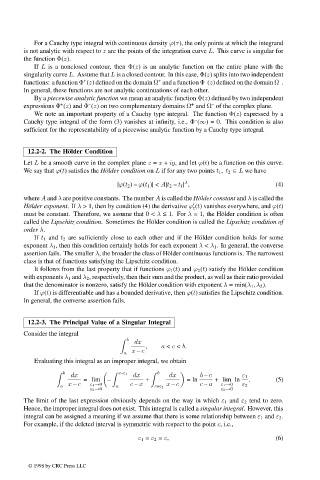Page 616 - Handbook Of Integral Equations
P. 616
For a Cauchy type integral with continuous density ϕ(τ), the only points at which the integrand
is not analytic with respect to z are the points of the integration curve L. This curve is singular for
the function Φ(z).
If L is a nonclosed contour, then Φ(z) is an analytic function on the entire plane with the
singularity curve L. Assume that L is a closed contour. In this case, Φ(z) splits into two independent
+
+
–
–
functions: a function Φ (z)defined on the domain Ω and a function Φ (z)defined on the domain Ω .
In general, these functions are not analytic continuations of each other.
By a piecewise analytic function we mean an analytic function Φ(z)defined by two independent
+
+
–
–
expressions Φ (z) and Φ (z) on two complementary domains Ω and Ω of the complex plane.
We note an important property of a Cauchy type integral. The function Φ(z) expressed by a
–
Cauchy type integral of the form (3) vanishes at infinity, i.e., Φ (∞) = 0. This condition is also
sufficient for the representability of a piecewise analytic function by a Cauchy type integral.
12.2-2. The H¨ older Condition
Let L be a smooth curve in the complex plane z = x + iy, and let ϕ(t) be a function on this curve.
We say that ϕ(t) satisfies the H¨ older condition on L if for any two points t 1 , t 2 ∈ L we have
λ
|ϕ(t 2 ) – ϕ(t 1 )| < A|t 2 – t 1 | , (4)
where A and λ are positive constants. The number A is called the H¨ older constant and λ is called the
H¨ older exponent.If λ > 1, then by condition (4) the derivative ϕ (t) vanishes everywhere, and ϕ(t)
t
must be constant. Therefore, we assume that 0 < λ ≤ 1. For λ = 1, the H¨ older condition is often
called the Lipschitz condition. Sometimes the H¨ older condition is called the Lipschitz condition of
order λ.
If t 1 and t 2 are sufficiently close to each other and if the H¨ older condition holds for some
exponent λ 1 , then this condition certainly holds for each exponent λ < λ 1 . In general, the converse
assertion fails. The smaller λ, the broader the class of H¨ older continuous functions is. The narrowest
class is that of functions satisfying the Lipschitz condition.
It follows from the last property that if functions ϕ 1 (t) and ϕ 2 (t) satisfy the H¨ older condition
with exponents λ 1 and λ 2 , respectively, then their sum and the product, as well as their ratio provided
that the denominator is nonzero, satisfy the H¨ older condition with exponent λ = min(λ 1 , λ 2 ).
If ϕ(t) is differentiable and has a bounded derivative, then ϕ(t) satisfies the Lipschitz condition.
In general, the converse assertion fails.
12.2-3. The Principal Value of a Singular Integral
Consider the integral
b
dx
, a < c < b.
x – c
a
Evaluating this integral as an improper integral, we obtain
dx dx dx b – c ε 1
b c–ε 1 b
= lim – + =ln + lim ln . (5)
x – c ε 1 →0 c – x x – c c – a ε 1 →0
a a c+ε 2 ε 2
ε 2 →0 ε 2 →0
The limit of the last expression obviously depends on the way in which ε 1 and ε 2 tend to zero.
Hence, the improper integral does not exist. This integral is called a singular integral. However, this
integral can be assigned a meaning if we assume that there is some relationship between ε 1 and ε 2 .
For example, if the deleted interval is symmetric with respect to the point c, i.e.,
ε 1 = ε 2 = ε, (6)
© 1998 by CRC Press LLC
© 1998 by CRC Press LLC
Page 599

